The 2013 MacBook Air Review (13-inch)
by Anand Lal Shimpi on June 24, 2013 12:01 AM ESTCPU Performance
To measure CPU performance we begin with a fairly standard measure of system responsiveness: boot time. With the last generation of upgrades to 6Gbps SATA, we saw a good decrease in boot time over the previous generation platforms. The new 13-inch MBA's PCIe SSD takes the crown as it boots ever so slightly quicker than last year's setup. In practice the difference is subtle, but something you can appreciate as the 2013 MBA's IO is just snappier all over.
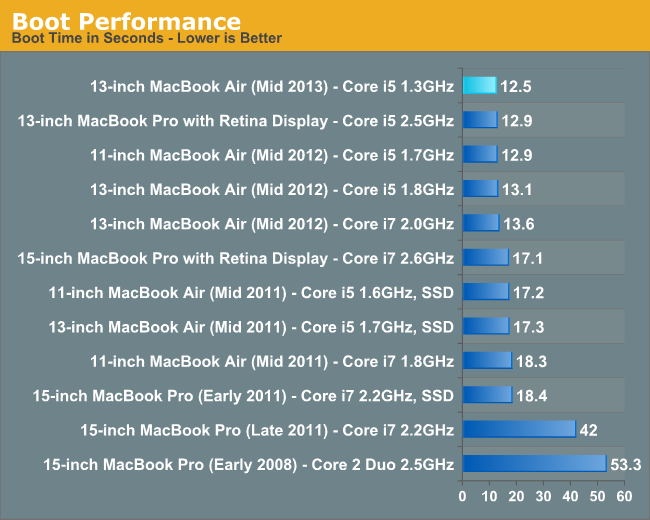
These next two charts look at single and multithreaded floating point performance using Cinebench 11.5. This test also gives us the rare opportunity of comparing to some older Mac Pro hardware as well from 2008 - 2010. Single threaded performance remains extremely important to overall system responsiveness, so it's always good to look at. As we found in our initial look at the new MBA, the 1.3GHz Core i5 CPU ends up performing about the same as last year's 1.8GHz part. I'd like to say it's all because of cooling and turbo boost, but in all likelihood Apple is trading some of Haswell's IPC gains for frequency here - enabling identical performance, at lower clocks thanks to Haswell's more efficient architecture.

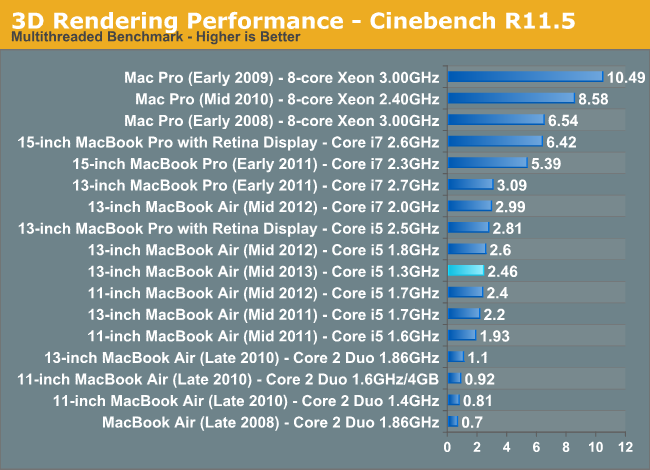
The multithreaded performance story is a bit different. The 1.3GHz i5 regresses in performance by about 5%. Overall performance is still quicker than the 2011 models, as well as the i7 based 11-inch MBA from 2012. Here we're simply seeing the 15W TDP limits come into play. Sharing both PCH and dual-core CPU power in a lower thermal footprint than last year's CPU alone is responsible for what we see above.
Video transcoding is really best suited for the higher end machines, but that doesn't change the fact that it's done on MacBook Airs as well. We'll start by looking at performance under iMovie. Here we're importing 1080p video from a Nikon D7000 and optimizing it during import.
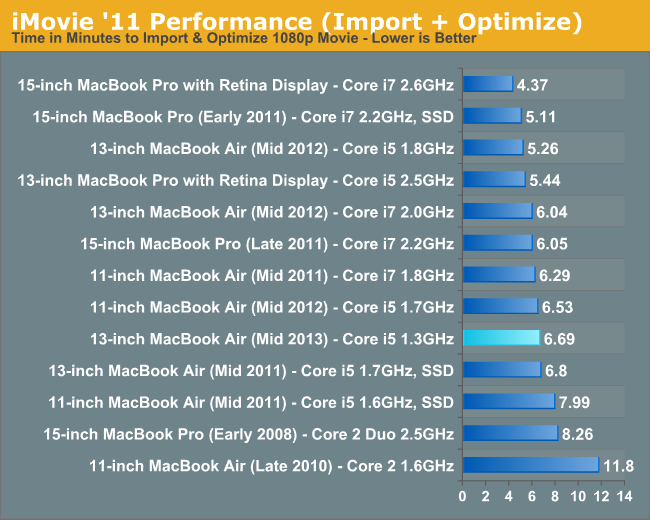
The 13-inch 1.3GHz Core i5 configuration performs similarly to last year's 11-inch 1.7GHz config. It's an interesting comparison because the 11-inch 2012 model is more thermally constrained than the 13-inch 2012 model, which is exactly what we see when we compare the 2013 13-inch MBA to the 2012 13-inch MBA. In this case the 2013 model is a hair quicker than the 2011.

We see a similar story for a full video export. The 1.3GHz 2013 MBA slots in behind the 2011 model in this CPU bound test.
Final Cut Pro X falls on the professional end of the video production spectrum. The test file is the same here, but the workload is far more strenuous.
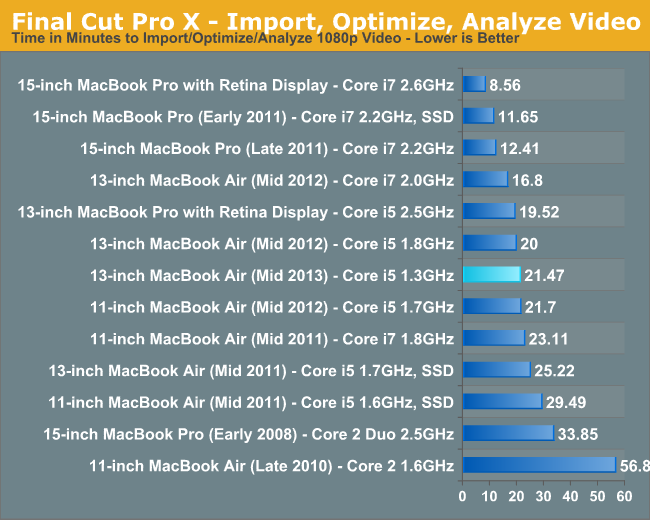
Once again, we see roughly the same performance from the 13-inch 2013 1.3GHz i5 as the 11-inch 2012 MBA. Here we do see substantially better performance than the 2011 models.
Our two photo workloads generally agree with what we saw in the video tests. The 1.3GHz Haswell part is definitely slower than th e previous generation 1.7/1.8GHz SKUs:
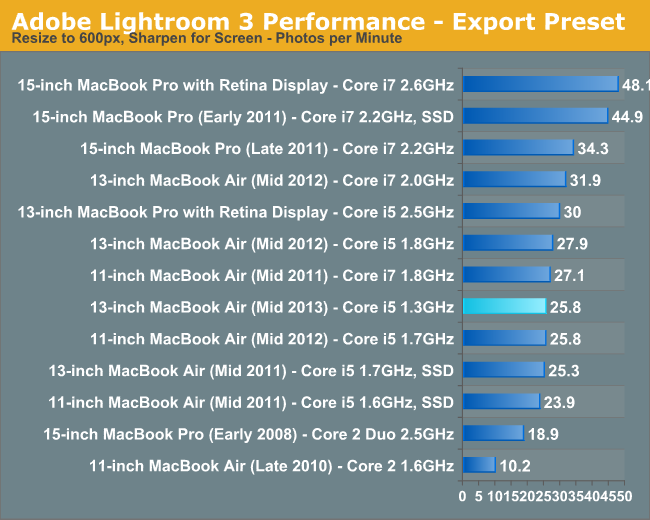

In our desktop review of Haswell I noted that performance in our compile test improved tremendously with the new architecture. As it's quite obvious that Haswell's IPC advantages don't surface all that much in our traditional suite, I wanted to see if perhaps things would be different in something that might lend itself better to Haswell's IPC improvements. I repeated our Firefox build test but under OS X. It's a multithreaded compile, with the number of threads set to 2x the number of cores (not threads) in a system. Unfortunately I came up with this bright idea while traveling, so I only had access to three machines: the 2013 13-inch MBA, the 15-inch rMBP and a 2GHz Core i7 2012 13-inch MBA. I'll add more results later, but I'm expecting this to be a part of our test suite going forward.

The combination of Haswell and a really fast SSD appears to help narrow the gap between the much higher clocked 2012 model and the base 2013 13-inch MBA. Here the faster Ivy Bridge CPU is less than 2% quicker. I'll reserve final judgements until I get my hands on the 1.7GHz Core i7 model, but my guess is this is an example of the best case scenario for Haswell where you get equivalent performance to a higher clocked Ivy Bridge part but with much better thermal/noise/battery life characteristics. For example, the fan was never audible on the 2013 MBA while running this test compared to running at a very noticeable volume on the 2012 Core i7 model. The same goes for temperatures. The i7 2012 model tends to run about 5% warmer along the bottom of the chassis compared to the 2013 i5.










233 Comments
View All Comments
Skolde - Monday, June 24, 2013 - link
I find the current display resolutions on these "premium" products to be very lacking for me to actually seriously consider a purchase. At least stick something in there like 1600x900.....1366 x 768? Come on!
Also - bumping the memory up to 8GB would be nice. I know it isn't build to be a workhorse, but still.
The XPS13 from Dell seems to be a much nicer option currently.
rangerdavid - Monday, June 24, 2013 - link
1440 x 900 on this 13".ddriver - Monday, June 24, 2013 - link
Why not, they put higher resolution on 5 inch phones...darwinosx - Monday, June 24, 2013 - link
They put higher resolution screens on their retina laptops. The Air focus on battery life and performance above all.designerfx - Monday, June 24, 2013 - link
except that's a problem. You can't take advantage of certain basic parts of *performance* if you have a terrible display.dsumanik - Tuesday, June 25, 2013 - link
Here is the non TLDR version of this review:"intel came out with a new CPU, samsung made a new SSD and apple slapped it together last minute in an existing design. Ultimately, You get a slower, longer lasting air for a 100 bucks less that carries over all the little annoyances from last year."
whoop dee f*ckin do……..This is apple innovation?
"the m.2 spec wasnt far enough along to be used in this generation"
Oh please, What a load of horse ****. I think anand, like many other review sites invested heavily in apple stock and are now trying to stop the bleeding. Apple has been deliberately stifling user upgrades for years….That is why they have proprietary connectors…ON EVERYTHING...your readers, and your reviewer knows this.
"The only thing that hasn't changed, that perhaps should have is the display. "
ya think? My phone has better rez. You've been criticizing PC makers for 2 years about the 1366x768 resolution, and here we have apple in 2013 and you say they "perhaps should have changed"
ROFL
Here are some "cheap" things they could have done to actually make this product an upgrade:
-move the thunderbolt port beside the power connector (no more stethoscope when plugged in driving a display)
-second thunderbolt port (now you can have 2 displays native and not be down a precious USB3)
-16gb ram availability (now I can run several VM's comfortably when developing)
-performance on par with last years MBA?
-nfc support
-4G support
here is some mild innovation they could have done:
-detachable screen (tablet notebook hybrid)
-retina display
-wireless desktop charger
3rd tier PC makers are coming out with better hardware than apple now, this year was critical and they've dropped the ball…with the exception of the Mac pro.
a smartwatch *could* be cool if it comes out totally water proof for active users…jogging swimming etc, if not i don't see the incentive to purchase unless it is super low cost.
what they need to "fix" the situation
-low cost iPhone (incoming 2013)
-large screen iPhone (2014)
-retina display across the board on all products (2015)
-updated thunderbolt display, USB3 and 4k Rez for under 2000 bucks.
-apple branded TV and home theatre system
-thunderbolt or USB3 sync speeds on all iDevices
Dump your apple stock now, it will bounce back but never to the highs it was previously.
Glindon - Wednesday, June 26, 2013 - link
Bored much?abazigal - Wednesday, June 26, 2013 - link
Can you name me all the other manufacturers who are implementing these features, much less doing them properly?You want retina, there's the 13" retina MBP. And I think he was criticising manufacturers for using 1366x768 res on a 13" laptop screen. Apple uses that for their 11" MBA line, which I find is still acceptable.
Apple decided that a slight decrease in performance was an acceptable tradeoff for longer battery life. And I am inclined to agree with them. The new processor speed still more than suffices for what typical consumers use it for anyways.
What am I supposed to do with NFC on a laptop? You want the power source to be beside the thunderbolt port. I don't think there is quite sufficient space for 2 USB ports on one side, and so long as it hooks up to your thunderbolt display just fine, does it really irritate you so that the two cables split up?
Personally, I feel there is nothing Apple "needs" to do. I am perfectly fine with their products. I like them, I buy them.
ysaykin - Saturday, July 13, 2013 - link
I think that in a way the comments are right. 11 inch laptops for $1000 should have some luxury features. One of those is amazing battery life, good keyboard, nice display, and good performance. The macbook air has some bases covered, but lacks the display. The resolution is fine for a sub $600 notebook but not at $1000, also a TN panel on a $1000 notebook sounds like a rip off. It should have been at least an ips panel. The longer battery life is only achievable because Mac OSx has been optimized for battery life, but if you use windows on the machine your battery takes a huge dip. So is it a good laptop, definitely, but is it worth the $1000 price? I think it's def a mac tax. Look at the Lenovo yoga which if updated to haswell would have awesome battery life, touchscreen, ips 1600x900 resolution, and convertible to tablet mode.rudolphbyers - Thursday, October 9, 2014 - link
There's nothing that could replace my MacBook Air! /Rudolph from http://www.consumertop.com/best-laptop-guide/